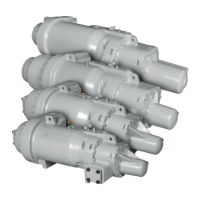13
Table 5 — Allowable Temperature Ranges
Compressor Rotation Control
Correct compressor rotation is one of the most critical
application considerations. Powered reverse rotation,
even for a very short duration, can seriously affect the
reliability of the compressor.
The reverse rotation protection scheme must be
capable of determining the direction of rotation and
stopping the compressor within 1 second.
Reve
rse rotation is most likely to occur at initial start-up
or whenever the wiring to the compressor terminals is
disturbed.
To minimize the possibility for reverse rotation operation,
Carlyle recommends the following procedures:
1. During initial run test of the unit, a suitable low-
pressure switch should be temporarily installed on
the high-pressure port of the compressor and be
wired to open the comp
ressor control circuit. The
purpose of this switch is to protect the compressor
against any wiring errors at the compressor terminal
pins. The electrical contacts of the switch must be
wired in the control circuit of the compressor start
components to shut off the compressor in the event it
is operating in reverse rotation. This switch would
remain in place for the duration of the run test. At the
end of the run test the switch would be removed so
that it could be used on the next unit or compressor
to be tested.
2. For service replacement compressors, a similar pro-
tection system is recommended. The unit service lit-
erature will make reference to this switch and provide
instructions on how to temporarily install the low-
pressure switch into the safety circuit for the com-
pressor. Each serv
ice compressor will be supplied
with Installation Instructions documenting the proce-
dure for installing and using the switch. The switch
will remain in place until the compressor has been
started and direction of rotation has been verified; at
this point the switch will be removed.
The low-pressure switch must be suitable for the pres-
sures consistent with R-134a systems, and the switch
must be ma
nually resettable and open when the pressure
falls below 50 mm (2 inches) of vacuum. The switch is a
manual reset type that can be reset after the pressure
has once again risen above 1.7 bar (25 psia). It is critical
that the switch be a manual reset type to preclude the
compressor from short cycling in the reverse direction.
If a switch is not available, a manifold gage connected to
the discharge
housing of the compressor BEFORE THE
DISCHARGE CHECK VALVE can be used. If the com-
pressor can be “bumped” or “jogged” very quickly (< 1
second) while someone is watching the gage, compres-
sor rotation can be determined without damage to the
compressor. If the pressure drops, the compressor is
rotating backwards and will have to be rewired. If the
pressure goes up, the compressor is spinning in the cor-
rect direction.
Refrigeration System Design Cons iderations
In order to eliminate the possibility of refrigerant migrat-
ing into the oil separator and compressor, Carlyle
requires
the application of a positive-seal, discharge
check valve (or a similar functioning device) to be
installed in the discharge line after the oil separator.
Carlyle recommends
the application of our qualified
Safety Control Module package (P/N 6BSB000472)
which provides the following safety control functionality:
• Discharge Temperature Monitoring
• Oil Level Monitoring (Optional)
• Reverse Rotation Monitoring
• Oil Flow-Rate/Supply Monitoring
Technical documentation for this Safety Control Module
package (P/N 6BSB000472) is provided on the Carlyle
Website at www.carlylecompressor.com
CONTROL
POINT
MINIMUM MAXIMUM
Discharge
Gas
20°F (11°C)
superheat
210°F (99°C)
Economizer
Gas
Saturated
Liquid
9°F (5°C)
superheat
Suction
Gas
Saturated
Va
por
Can float if motor
and discharge
maximum temps
are met
Oil Supply at
Compressor
Refer to Fig. 8 210°F (99°C)
Motor
Windings
No limit 275°F (135°C)

